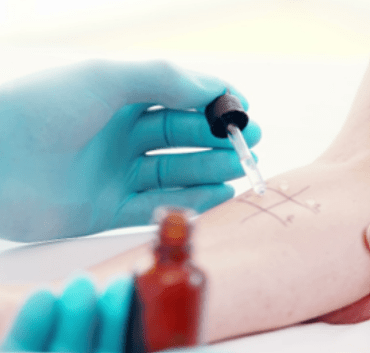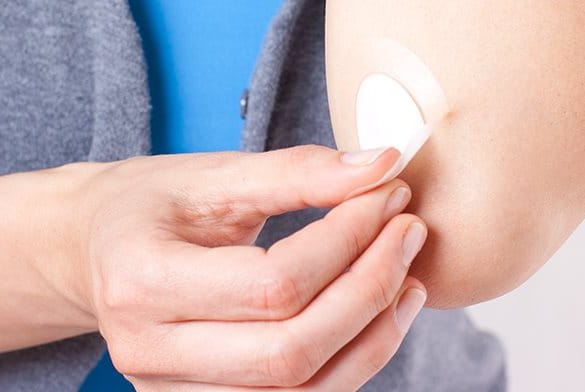If you've ever noticed a change in your skin after using a plaster, chances are you may have a plaster allergy. Plasters use adhesives to enable them to protect wounds by sticking to the skin. An allergic reaction to plasters could mean you're allergic to rubber, latex, or other adhesive materials in the bandage like topical glues.
Plaster allergy symptoms can usually be treated at home if they're mild. In this article we explain how to diagnose an allergic reaction to plasters, the symptoms, how to treat a plaster allergy and what hypoallergenic plasters are available at Elastoplast.
What does an allergic reaction to plasters look like?
Symptoms of a plaster allergy can occur immediately on contact with your skin, or a day or two after using a plaster. The following symptoms indicate an allergic reaction to plasters:
- red or bumpy rash, which may be itchy
- sensitivity
- small papules (bumps)
- swelling or inflammation
- dry or flaky skin
- blistering and pain (in severe cases)
What causes a plaster allergy?
A plaster allergy isn't uncommon. Children or those with sensitive skin are more likely to be allergic to plasters. Switching plaster brands can also trigger an allergic reaction to plasters, because your skin isn't used to the different adhesives.
Both the outermost layer of skin (the epidermis) and the layer just below (the dermis) are affected in this localised skin reaction.
Contact dermatitis from a plaster allergy
There are two types of contact dermatitis reactions that can be caused by an adhesive allergy:
Irritant contact dermatitis: This happens when an irritating material, like soap, detergent or an antibacterial, comes into contact with the skin. Those with atopic eczema are more vulnerable to irritant contact dermatitis. While it's the more common reaction, irritant contact dermatitis is not a true allergic reaction.
Allergic contact dermatitis: This occurs when the skin comes into contact with something a person is allergic to, and the allergen triggers a localised immune response. This leads to more severe symptoms but usually only affects the contact area, and the reaction may show up later after the substance has been removed. Symptoms can worsen with each exposure.
Latex allergy
Many products use latex, which is a naturally occurring rubber. Some adhesive plasters are made with this material, so it is possible the plaster allergy could be caused by its presence in the applied object (rather than the topical glues). Reactions and symptoms vary, and some may not even be aware they have a latex allergy.
People with occupational exposure to latex proteins, like healthcare providers, beauticians, or people in the rubber industry, are more likely to develop a latex allergy and be allergic to plasters.
Diagnosing a plaster allergy

Usually, it's relatively straightforward to diagnose an adhesive allergy because the allergic reaction occurs directly underneath or around where the adhesive plaster was applied, causing the body to produce an immune response.
Your GP may diagnose your allergic reaction, but if the cause is uncertain, they may refer you to a dermatologist or allergy specialist. Allergy tests may be used to discover the exact cause(s) of a plaster allergy:
- Patch testing: This involves applying a small number of common allergens to an area of skin - typically on the back - using non-latex patches. Between 30-100 different allergens could potentially be applied, and reactions are observed to determine the allergen.
- Skin prick test: Tiny amounts of various allergens are inserted beneath the skin surface to check for immediate allergic reactions to as many as 50 substances at once. This method is usually done on the forearm, and can help identify allergies to pollen, latex, mould, dust mites and foods.
Are Elastoplast plasters hypoallergenic?

To help prevent allergic reactions to plasters, you should use the right type of plaster for your skin. If you have a latex-allergy or very sensitive skin, we recommend using the Elastoplast Sensitive or Sensitive Kids products. Elastoplast Sensitive hypoallergenic plasters are latex-free and very skin friendly.
These hypoallergenic plasters protect wounds, are painless to remove and are also suitable for diabetics. The Sensitive range is also available in light, medium and dark skin tones.
How to treat an allergic reaction to plasters
Since the plaster allergy reaction is contact-based, symptoms should subside within a day or two once the adhesive has been removed. Note that sometimes removing a plaster will leave residue on the skin so the area should be properly cleaned. Find out how to remove plaster marks and residue here.
The following methods can be used for non-severe allergic reactions to plasters:
- Cold compress
- Anti-itch creams
- Emollients or moisturisers
- Antihistamines
- Oat bath
If your rash does not clear up after a couple of days, you should speak to your GP. While the above treatment will usually suffice, more severe reactions may require topical corticosteroids, like hydrocortisone 1% cream, which can help soothe rashes and reduce inflammation. These should only be used for a short amount of time.
If you're pregnant or breastfeeding, you should contact your GP to discuss a suitable treatment.






